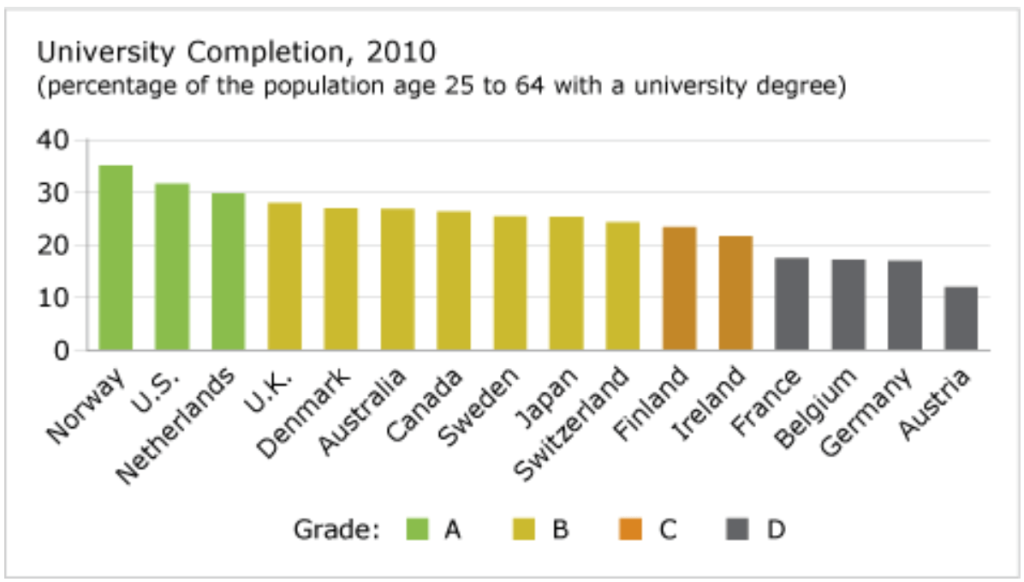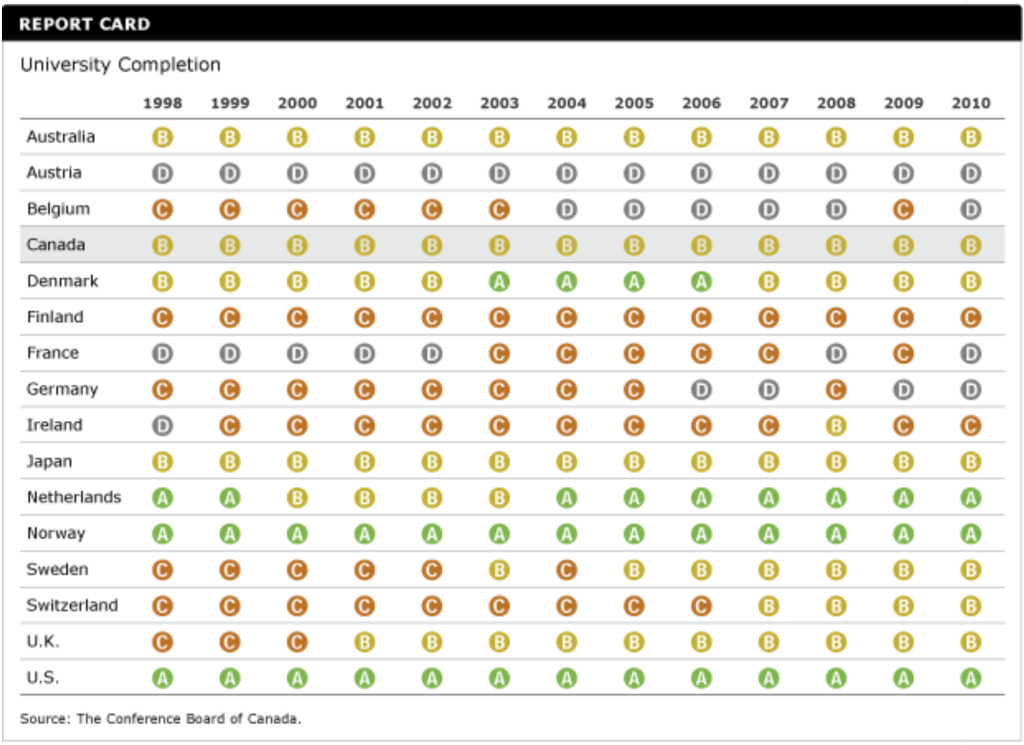University Completion
Key Messages
- Canada earns a “B” and ranks 7th out of 16 peer countries.
- Canada’s participation rate has increased, but not enough to move Canada up in the ranking.
- Given the gap between Canada and leading competitors, it would take many years of increasing university enrolment to change Canada’s ranking.

Putting university completion in context
Governments have plenty of evidence that well-educated citizens are more actively engaged in society: they tend to make better choices about factors that affect their quality of life (e.g., diet, smoking, exercise); and they earn higher incomes than those who are less educated. Less prominent in the mind of the public, but equally well-known among decision-makers, is the fact that well-educated and skilled people make important contributions to business innovation, productivity, and national economic performance. In an interconnected global economy, countries with more highly skilled workers have a distinct competitive advantage.
How does Canada’s university completion rate compare to that of its peer countries?
Canada has not been an “A” performer on university completion in any year between 1998 and 2010 (the only years for which data are available). Nearly 27 per cent of working-age Canadians have a university degree, which is above the 16-country average, but not high enough to catch up to the leaders. Norway, for example, boasts a university completion rate of 35 per cent.
Has Canada’s university completion rate increased over time?
Since 1998, Canada has earned a “B” for its university completion rate. While Canada’s completion rate grew from 18 per cent in 1998 to nearly 27 per cent in 2010, it is evidently not the only peer country with success in this area. Canada must continue to increase its rate merely to maintain its ranking. If it wants to catch up to those at the top of the class, Canada will have to push for even more dramatic increases.

Is Canada likely to close the gap on the leading countries?
Although Canada has an admirable record in this area, it will have a difficult time catching up to the leaders. University enrolment rates have been increasing in Canada, and more Canadians are completing university now than they were a decade ago. Canada’s improved completion rates have helped it to edge closer to its higher-ranking peers, but it will not close the gap on leaders such as Norway and the United States any time soon.
Why? First, the U.S. has a somewhat younger population than Canada, meaning that the number of university-age people is likely to increase faster in the U.S. than in Canada over the longer term. Moreover, as Canada’s performance has improved, the U.S. has simultaneously increased the percentage of its population with university degrees—albeit at a slower rate than Canada—so the target is moving away as Canada approaches it.
If we assume that the university completion rate for each country will continue to grow at the average annual rate of the last five years, Canada’s university completion rate will not surpass that of the U.S. until 2026.
Is a university degree better than a college diploma?
It has long been argued, based on income data, that university completion is the most relevant indicator of Canada’s ability to produce highly talented, innovative people. The “returns on education” data support this argument, since university graduates, as a group, earn more, on average, than college graduates do.
However, recent research suggests the field of study may be more important than the type of academic institution attended. One study, for example, found that males with university degrees in academic disciplines—such as the humanities, education, biology, and agriculture science—earned less than half of that earned by males with university degrees in vocational and applied disciplines—such as commerce, medicine, and engineering.1 Another study identified similar differences in earnings for college disciplines in Canada and found that these discrepancies drove enrolments toward disciplines with higher earnings expectations.2 Perhaps the distinction between college and university is less important than the relevance of the discipline to the workplace, since it is relevance—along with supply and demand—that sets the market price for skilled talent.
Footnotes
1 Alan Stark, Which Fields Pay, Which Fields Don’t? An Examination of the Returns to University Education in Canada by Detailed Field of Study (Ottawa: Department of Finance Canada, February 2007).
2 Brahim Boudarbat, Earnings and Community College Field of Study Choice in Canada, Discussion paper (Bonn: Institute for the Study of Labour, May 2004).

